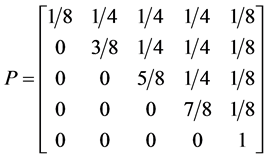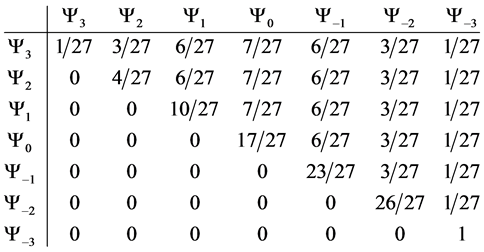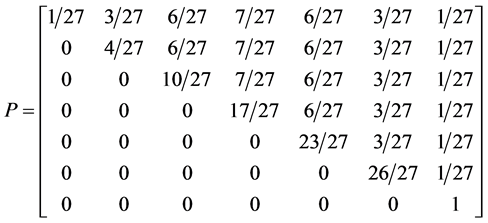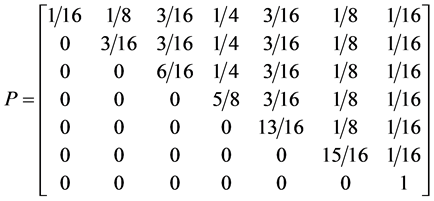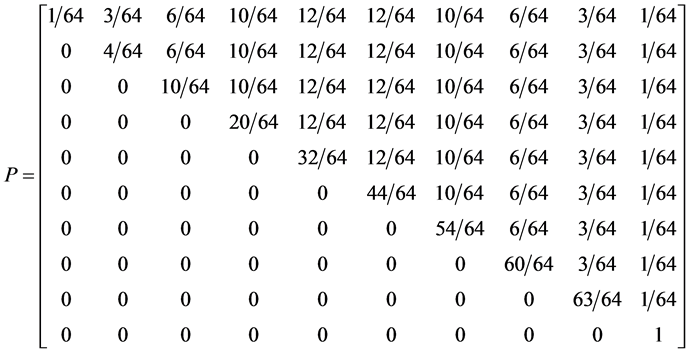Applied Mathematics
Vol.07 No.07(2016), Article ID:66038,15 pages
10.4236/am.2016.77060
Energy-States of Particles with Representational Spin
Ricardo Suarez1, Gregory G. Wood2
1Department of Mathematics, CSU Channel Islands, Camarillo, CA, USA
2Department of Physics, CSU Channel Islands, Camarillo, CA, USA

Copyright © 2016 by authors and Scientific Research Publishing Inc.
This work is licensed under the Creative Commons Attribution International License (CC BY).
http://creativecommons.org/licenses/by/4.0/



Received 7 March 2016; accepted 25 April 2016; published 28 April 2016
ABSTRACT
In this paper, an algorithm to produce a transition matrix between all states in ideal anti-para- magetic system under the simulated annealing condition that only moves to lower energy states are accepted. The check the accuracy of the transition matrix is confirmed by computer simulation, showing close agreement between model and simulation results.
Keywords:
Markov Chain Monte Carlo, Simulated Annealing, Spin 1/2 Particles

1. Introduction
In this paper we compute all transition probabilities of a system of N isolated particles of spin M to move to any lower energy state. In each move, the current state , is compared with a random trial state,
, is compared with a random trial state, . The move is accepted if it the trial state has a lower energy, and rejected if the energy is equal, or higher. No restrictions are placed upon the trial state: it is totally random, thus the states form a Markov chain [1] which the next state chosen at random, via the Monte Carlo method [2] . This is a kind of simulated annealing [3] , but with a simulation temperature of zero [4] , which continues to be relevant within the context of recent work [5] . The system will approach its idealized energy state, with net magnetic moment
. The move is accepted if it the trial state has a lower energy, and rejected if the energy is equal, or higher. No restrictions are placed upon the trial state: it is totally random, thus the states form a Markov chain [1] which the next state chosen at random, via the Monte Carlo method [2] . This is a kind of simulated annealing [3] , but with a simulation temperature of zero [4] , which continues to be relevant within the context of recent work [5] . The system will approach its idealized energy state, with net magnetic moment  , where
, where  is the magnetic moment of one particle, with energy
is the magnetic moment of one particle, with energy , with entropy
, with entropy . For the context of this paper, we will consider the system to be an diamagnet, with the external magnetic field pointing up, the ground state (lowest energy) for the system will be when all spins point down.The least preferred state will be the state that has all spins up. Results are essentially the same for paramagnetic systems, but with the transition matrix is the flipped.
. For the context of this paper, we will consider the system to be an diamagnet, with the external magnetic field pointing up, the ground state (lowest energy) for the system will be when all spins point down.The least preferred state will be the state that has all spins up. Results are essentially the same for paramagnetic systems, but with the transition matrix is the flipped.
This is an unusual use of simulated annealing. Normally, simulated annealing is used to find a solution to a complex problem, such as the optimal path in the traveling salesman problem. In complex magnetic systems, such as spin glasses, simulated annealing is used to find the optimal ground state [6] . By contrast, in this paper, the system is rather simple and the optimal state is known. Thus we can compute the probability to move from any state to any other state which should lend insight into how this very powerful tool (simulated annealing) operates. We can pause the simulation at any point, and since we know the optimal state, measure how far the system is from optimal, The number of moves to find the best state increases rapidly with the complexity of the system. In the magnetic systems we study in this paper, this complexity can be increased by increasing the number of spins in the system, or by increasing the spin of each particle. Either way greatly increases the number of states for the system to explore.
1.1. Plan of the Paper
Beginning with two, three and four spin one half particle states, the transition probabilities between all states are enumerated. These lists of probabilities are formed into matrices. This is repeated for spin one particles in section 2 where the transition probabilities are derived from the degeneracy of the states. These degeneracies employ the generalized binomial coefficients, called the multinomials. In Section 3, the spin 3/2 particles are considered. Then, in Section 4, the entries in the transition matrices are derived from the degeneracy of the states, using a simple summation rule. In Section 5, degeneracy vectors are given for various systems. In Section 6, the results of numerical simulations are provided which confirm the results of the matrix calculations.
1.2. Assumptions of Model
Our underlying assumptions are:
・  , thus eliminating the effects of entropy
, thus eliminating the effects of entropy 
・  states gravitate towards more preferred states of lower magnetism number due to our model being an anti-paramagnet
states gravitate towards more preferred states of lower magnetism number due to our model being an anti-paramagnet
・ Particles in  are indistinguishable.
are indistinguishable.
In any system N-particles with spin we will assign values. Those values will be relative to the system we are working with. We will assign +1 for spin up, and values −1 for spin down in a spin one half system. +1, 0, −1 for a spin one system, and ,
,  for a spin 3/2 system. The magnetism number will be achieved by virtue of the magnetism operator S.
for a spin 3/2 system. The magnetism number will be achieved by virtue of the magnetism operator S.
Definition 1.1. For any state  in a N-particle system we define S to be the operator such that
in a N-particle system we define S to be the operator such that  where
where  is the total spin up,
is the total spin up, 
Definition 1.2. For any two states






Definition 1.3. For any N-particle system. 
Definition 1.4. let 
Definition 1.5. The cardinality of the set

This leads us to the following proposition.
Proposition 1.6. There can only be one idealized Ground state;
that is
Poof. The only way to get magnetism number 

Definition 1.7. let 

is the set of all states that are preferred to a state with magnetism number
1.3. Markov Chains
Definition 1.8. A system with a finite or countably infinite number of states with the property that given a present state, past states have no influence on the future is known as a Markov chain
Definition 1.9. Markov chains have the property that for a random variable
where 
Definition 1.10. Let 



From the transition function 
P is known as the transition matrix for the Markov chain. We will now apply the concepts of a Markov chain directly to our model.
2. Markov Chains and Our Model
We will use Markov chains to model the transition states for spin 1/2, spin 1, or spin 3/2 particles. For our model of N-spin particles the state space 

We begin by defining the probability function for our model.
Definition 2.1. Let 


where N is total number of particles in the system,
and 
Since our Markov chain has the property of only transferring to preferred states, our transition probabilities are defined by the following transition function.
This transition function shows how transition probabilities are absorbed when we move to a preferred state from a less desired state. This probability absorption allows us to construct upper triangular square transition matrices of the following form.
Our understanding of the transition function and the transition matrix of our model leads to the following 2 propositions .
Proposition 2.2.
Poof. Staring with
Now 

Giving us the desired result.
Proposition 2.3. For the idealized ground state
Poof. By proposition 4.2
We will now look at Markov chains and the spin 1/2 particle.
3. Spin 1/2 Particles
3.1. Two Spin One Half Particles
For a two spin one half particles, the only possibilities of spin configuration of the fermions look like this
・ 
・ 

・ 
Thus 
Giving us the following probability transition table
With transition matrix
For example we would read

our probability matrices upper triangular. Which for our model denotes that system is probabilistically approaching the idealized ground state. Since read 

3.2. Three Spin One Half Particles
For a system of three spin one half particles, the only possibilities of spin configuration of the fermions look like this
・
・
・
・
Thus 

Although we can clearly see what the probability of landing in each state is, we can use basic counting arguments to show our results mathematically. Thus
・
・
・
・
Giving us the following probability transition table
With transition marix
Example 3.1. Given the transition matrix for the three spin one half particle system, above, we can calculate the probablity of moving to a preferred state.
・
・
・
・
With our understanding of the three spin one half particle case and counting arguments, we can develop a generalization for any N spin one half particle system.
3.3. N-Spin One Half Particle System
Now given our understanding of the probabilities we can build the probability transition matrix for any N-fer- mion system. If 

And with 

Leading us to the following definition.
Definition 3.2. For any N-fermion system we can calculate 


Definition 3.3. For any N-fermion system we can calculate 

With these result we can calculate the probability of our system moving to a better state, given any N-fer- mions and
4. Spin One Particles
For the spin one particles we will assign 

4.1. System of Two Spin One Particles
A system with two spin one particles has the following states:
・ 

・ 
・ 

・ 
・ 

・ 
・ 

・ 
Thus for a system of two spin one particles, the state space 





With the following transition matrix
4.2. System of Three Spin One Particles
For a system of three spin one particles the possible states are given by the macro-states






・
・
・
・
・
・
・
Thus in terms of probabilities:
These probabilities give us the following transition table.
With the following transition matrix.
Notice that listing out all appropriate micro states gets a bit cumbersome, but unlike the spin 1/2 particles, the spin one particles have 3 possible spins. So to calculate their probabilities with the aid multinomial probability formula.
Now with this formula we are able to calculate the probability of the macro states for a 4 spin one particle system.
4.3. 4 Spin One Particle System
For a spin one system with 4 particles we find macro states 

・
・
・
・
・
・
・
・
・
Giving us the following Transition table
Along with the following transition matrix
We now generalize our results with the following formulas
Definition 4.1. For any N-spin one particle system and a given macro state 

where 
If n-even m-even, or n-odd m-odd
If N-even m-odd, or N-odd m-even
And for the zero case we get the following.
Definition 4.2. Let 
Now with this result we can calculate the probability of our system moving to a preferred state, given N-spin one particles and
We now turn our attention to a system of spin 3/2 particles.
5. Spin 3/2 Particles
Now we turn our attention to spin 3/2 particles. We will de-note all the possible states a particle can take with
the set
To give the spin 3/2 particles integer coefficients we simply represent them in the set
5.1. Two Spin 3/2 Particle System
A two spin 3/2 particle system has the following states
・ +3, +3
・ +3, +1
・ +3, −1
・ +3, −3
・ +1, +3
・ +1, +1
・ +1, −1
・ +1, −3
・ −1, +3
・ −1, +1
・ −1, −1
・ −1, −3
・ −3, +3
・ −3, +1
・ −3, −1
・ −3, −3
The two particle system gives us the following states 
・
・
・
・
Giving us the following probability transition table
With the following transition matrix
5.2. Three Spin 3/2 Particle System
For a system of three spin 3/2 particles we calculate the state space in the same manner as we did in the two spin 3/2 particle system. Giving us the following state space
With the following probabilities:
This results in the following transition table
With the following transition matrix
5.3. Four Spin 3/2 Particle System
With the aid of the multinomial formula we are able to calculate the probabilities of the state space
・
・
・
・
・
・
・
Which gives us the following degeneracy transition table, with 
And the transition matrix
With D being the following matrix
With D being the degeneracy matrix. Notice that we can construct any transition probability matrix from just understanding degeneracy matrix D. Thus given our systems it suffices to understand degeneracies in order to construct their transition probabilities.
6. Degeneracy Matrix Algorithm
As we saw in the previous section we can find all the transition probabilities from any j spin-N particle system under assumptions:
・ 
・ 
・ Particles in 
With Probability transition matrix P
To construct D let 

With 

We will now use the degeneracy vector to construct the degeneracy matrix.
6.1. Algorithm for Constructing D
For simplicity we will construct D from our degeneracy vector which we will denote 
Thus it follows that
thus we can rewrite 
Using 

6.2. Degeneracy Vector (d1) for Spin One Particles for n = 5, 6, 7, 8, 9, 10
From the preceding section, we see that we can construct the probability transition matrix of a system solely by means of the degeneracy vector. Now here are the degeneracy vectors for n = 5, 6, 7, 8, 9, 10.
・ for n = 5
・ for n = 6
・ for n = 7
・ for n = 8
・ for n = 9
・ for n = 10
6.3. Degeneracy Vector (d1) for Spin 3/2 Particles for n = 5, 6, 7, 8
・ for n = 5
・ for n = 6
・ for n = 7
・ for n = 8
7. Results from Numerical Simulations
Two systems are studied: a small system with 10 spin 1/2 particles giving 1024 possible states, and a larger system with 20 spin 1/2 particles, with about a million possible states. The system begins in the least optimal state, all spins pointing up, and at each move, a random trial state is generated. If the trial state is more optimal, meaning it has fewer spins pointing up, it is accepted. It is highly probable the first move will be accepted. After many moves, the likelihood of improvement diminishes. We consider three “times” to illustrate the relative movement slowing at large time: after 9, 81 and 729 moves, so the moves are evenly spaced in log time. The simulation is run one million times for the small system, and one hundred thousand times for the large system. The results are displayed in Figure 1 and Figure 2, and are consistent with the calculation of predicted number at each, as shown in Table 1 and Table 2, below.
Figure 1. Histogram of number of states having various net spin as a function of time. Ten spin one half particles are simulated one million times. The x-axis is the number of spins pointing up, at various times. The y-axis is the number of replicas of the system where this was found, proportional to the probability. Three times are given, in different colors, receding into the page, as: red (9 steps) green (81 time steps) and blue (729 time steps). The distribution is roughly Gaussian, and the distribution moves toward lower numbers of spins pointing up over time, but slowly. Numeric values are given in Table 1, along with computed values from the transition matrices from the formula above.
Figure 2. Histogram of number of states having various net spin as a function of time. The x-axis is the number of spins pointing up. The y-axis is the number of replicas of the system which have the given x-axis value of spins up, and so the y-value is proportional to probability. Twenty spin one half particles are simulated over 729 Monte Carlo steps. One hundred thousand replicas of the system are used. Three times are displayed: after nine steps (red), after 81 steps (green) and after 729 steps (blue). The system has just over one million possible states, and so unlike in figure one, above, 729 steps are not nearly enough to get any significant fraction of the system into the optimal (x-axis value zero) state. However, despite the odds of moving to the optimal state being somewhat worse then one in a million, after only 729 moves, the system is pretty close to optimal: most likely the system has three or four spins pointing up out of 20. Beyond this time, progress is slow.
Table 1. Results from one million replicas of a system of ten spin one half particles. Close agreement is found between simulations and model calculations. Time steps (in the first column) are measured in monte carlo simulation steps. The number of systems, out of a total of one million, in the ground state is given by N0, and the number in the first excited state, one spin up, given by N1. Columns denoted by sim are from simulated annealing computations, and columns denoted by model are from the model. The simulation results are presented in the first two columns of figure one. Note that all numbers of spins are given in thousands of spins.
Table 2. Results from one hundred thousand replicas of a system of twenty spin one half particles. Close agreement is found between simulations and model calculations. Time steps (in the first column) are measured in monte carlo simulation steps. The number of systems, out of a total of one hundred thousand, in the ground state is given by N0, and the number in the first excited state, one spin up, given by N1. Columns denoted by sim are from simulated annealing computations, and columns denoted by model are from the model. The simulation results are presented in the first two columns of figure two. Note that in contrast to Table 1, above, numbers of spins are not multiplied by 1000. This starkly illustrates the vast increase in the number of available states of the system, and the very slow rate at which simulated annealing will converge to anywhere near the ground state. In Table 1, above, 99% of the replicas were in the ground or first excited state after 729 moves, but in this larger system, only 1.4% are in the two lowest states.
8. Conclusion
For ideal anti-paramagnetic systems, an algorithm for generating a transition matrix is given, with the constraint that the simulated annealing rule is followed; that only transitions to lower energy are allowed. This matrix is confirmed by direct simulated annealing simulations.
Acknowledgements
We thank the Editor and the referee for their comments.
Cite this paper
Ricardo Suarez,Gregory G. Wood, (2016) Energy-States of Particles with Representational Spin. Applied Mathematics,07,650-664. doi: 10.4236/am.2016.77060
References
- 1. Markov. A.A. (1971) Extension of the Limit Theorems of Probability Theory to a Sum of Variables Connected in a chain. Reprinted in Appendix B of: R. Howard. Dynamic Probabilistic Systems, Volume 1: Markov Chains. John Wiley and Sons.
- 2. Curtiss, J.H. (1953) Monte Carlo Methods for the Iteration of Linear Operators. Journal of Mathematics and Physics, 32, 209-232.
http://dx.doi.org/10.1002/sapm1953321209 - 3. Kirkpatrick, S., Gelatt Jr., C.D. and Vecchi, M.P. (1983) Optimization by Simulated Annealing. Science, 220, 671680,
http://dx.doi.org/10.1126/science.220.4598.671 - 4. Cerny, V. (1985) Thermodynamical Approach to the Traveling Salesman Problem: An Efficient Simulation Algorithm. Journal of Optimization Theory and Applications, 45, 4151.
http://dx.doi.org/10.1007/BF00940812 - 5. DiStasio Jr., R.A., Marcotte, E., Car, R., Stillinger, F.H. and Torquato, S. (2013) Designer Spin Systems via Inverse Statistical Mechanics. Physical Review B, 88, Article ID: 134104.
http://dx.doi.org/10.1103/PhysRevB.88.134104 - 6. Grest, G.S., Soukoulis, C.M. and Levin, K. (1986) Cooling-Rate Dependence for the Spin-Glass Ground-State Energy: Implications for Optimization by Simulated Annealing. Physical Review Letters, 56, 1148-1151.
http://dx.doi.org/10.1103/PhysRevLett.56.1148














































